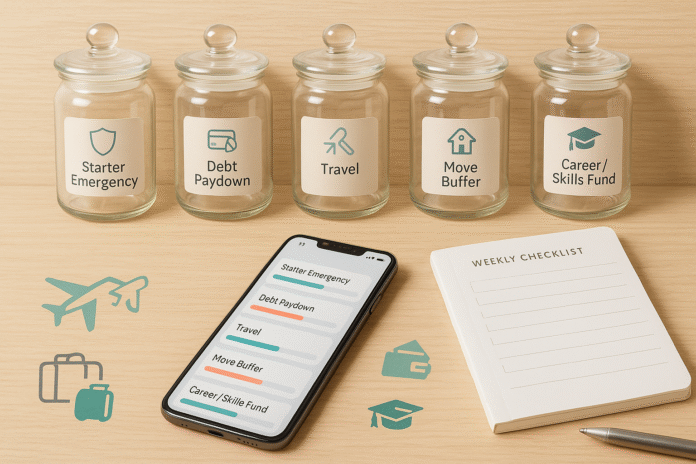If you’re juggling rent, subscriptions, student loans, and an Instagram feed full of “treat yourself” temptations, short-term savings can feel like a distant dream. The good news: you don’t need a six-figure salary or a finance degree to make real progress. With a handful of targeted, practical goals—and a system you can run on autopilot—you can build momentum fast. This guide breaks down the top 5 short-term savings goals for millennials, shows you exactly how to set them up, and gives you tools to measure progress without turning your life into a spreadsheet.
Disclaimer: This article is for educational purposes only and is not financial advice. Everyone’s situation is different. Consider speaking with a qualified financial professional for guidance tailored to you.
Key takeaways
- Start small, win early. Focusing on five focused, short-term goals builds confidence and protects you from setbacks.
- Automate everything. Consistent, automatic transfers beat bursts of motivation.
- Make goals measurable. Tie each goal to a number, a date, and a simple weekly action.
- Protect your cash. Keep safety-first money in insured, liquid accounts and know your deductibles and out-of-pocket risks.
- Track the right metrics. Use simple KPIs—days of expenses saved, % funded per goal, savings streaks, and debt interest avoided.
Quick-start checklist
- Open a separate high-liquidity savings account for your emergency cash and short-term goals.
- Turn on automatic transfers (weekly or on payday).
- Name your sub-accounts (or “buckets”) for clarity: “Starter Emergency,” “Move Fund,” “Travel Fund,” etc.
- Set target amounts + target dates for each goal.
- Establish default contributions (e.g., 5–10% of take-home or a fixed amount).
- Schedule a 15-minute monthly money check-in to review progress, adjust contributions, and celebrate wins.
1) Build a Starter Emergency Fund
What it is & why it matters
A starter emergency fund is your first line of defense against nasty surprises—flat tires, sudden medical bills, lost phone, or hours cut at work. It prevents one bad week from turning into months of interest charges or drained future-you savings.
Core benefits
- Reduces stress and avoids high-interest debt when life happens.
- Creates breathing room so you can follow through on other goals.
- Builds a habit of paying yourself first.
Requirements & low-cost alternatives
- Where to keep it: A liquid savings account you can access quickly. Funds in standard deposit accounts at insured institutions are typically covered up to specific limits per depositor, per institution, and per ownership category.
- Tools: Banking app with automatic transfers and goal naming.
- Low-cost alternative: If a new account isn’t possible, use your current savings account but rename it in your app (e.g., “Starter Emergency Only”) and hide it from the main dashboard if your bank allows.
Step-by-step (beginner-friendly)
- Pick a first milestone. Choose a concrete starting target (e.g., $500, $750, or $1,000) or one month of bare-bones expenses.
- Automate it. Set a transfer for every payday (e.g., $25–$75).
- Park windfalls. Direct tax refunds, cash gifts, side-hustle income, rebates, or marketplace sales to this fund.
- Define emergencies. Create rules: car repair, medical bill, lost income = yes; concert tickets = no.
- Review monthly. If your cash flow improves, increase the recurring transfer.
Beginner modifications & progressions
- If money is tight: Start with micro-transfers ($5–$10 per payday).
- If cash flow is uneven: Use percentage-based transfers (e.g., 5–10% of each deposit) rather than fixed dollars.
- Progression: After hitting your starter target, aim for 3–6 months of essential expenses over time.
Frequency, duration & metrics
- Frequency: Weekly or payday transfers.
- Duration: Until you reach your starter goal; then continue building toward your larger cushion.
- Metrics:
- Days of expenses saved (target 30 days first).
- Savings streak length (consecutive automated transfers).
- % of goal funded.
Safety, caveats & common mistakes
- Safety first: Keep emergency money liquid and in insured accounts.
- Caveat: Don’t chase higher yields at the expense of liquidity or safety for this specific goal.
- Avoid: Using the fund for predictable expenses (birthdays, car registration). That’s what sinking funds are for (see Goal #3).
Sample mini-plan (2–3 steps)
- This payday: Open/label your emergency account; start a $40 weekly transfer.
- Next payday: Add $25 from side hustle.
- Monthly review: Increase the weekly transfer by $10 if you came in under budget.
2) Eliminate (or Cushion) High-Interest Debt with a “Paydown Fund”
What it is & why it matters
A “paydown fund” is a short-term savings-plus-payment plan that targets high-interest balances (often credit cards) quickly and systematically. Many issuers calculate interest daily, so sooner payments mean less interest. Two classic approaches exist:
- Avalanche: Target highest interest rate first (mathematically fastest).
- Snowball: Target smallest balance first (motivational boosts).
Core benefits
- Cuts interest costs and accelerates net worth.
- Frees up monthly cash flow for other goals faster.
- Protects your credit utilization, a major input in widely used scoring models.
Requirements & low-cost alternatives
- Needs: List of debts (balance, APR, minimum payment, due date), calculator, and a dedicated “Paydown” savings bucket.
- Low-cost alternative: If you can’t open a new bucket, tag paydown transfers in your budgeting app and send extra principal payments immediately rather than holding cash.
Step-by-step (beginner-friendly)
- Inventory debts. Record balances, APRs, and minimums.
- Choose a method. Avalanche for less interest overall; Snowball if you need quick wins.
- Automate:
- Minimum payments on all debts.
- A recurring extra amount to the current target debt (via your “Paydown” bucket or direct extra payment).
- Tighten leaks. Pause nonessential subscriptions or renegotiate bills; redirect savings to the paydown.
- Rinse & repeat. When a debt is paid, roll its payment to the next target.
Beginner modifications & progressions
- If cash flow is tight: Start with $20–$30 extra per payday.
- If motivation dips: Switch from avalanche to snowball for a quick morale win, then switch back.
- Progression: After high-interest debts are gone, redirect that same monthly amount to other goals.
Frequency, duration & metrics
- Frequency: Monthly minimums + biweekly/weekly extra payments.
- Duration: Until the target balances are cleared.
- Metrics:
- Total interest saved (estimate using a calculator).
- Months to debt-free date (recalculate monthly).
- Credit utilization trend (aim lower over time).
Safety, caveats & common mistakes
- Avoid: Skipping minimums to pay extra on a target—always protect your payment history.
- Caveat: Balance transfers may include fees and could reset if you miss a payment.
- Safety: Keep at least a tiny emergency buffer while paying down debt to avoid re-borrowing after a surprise expense.
Sample mini-plan (2–3 steps)
- Today: List all debts in a note.
- This week: Set automation for minimums + $60 extra to the highest APR card.
- Next month: Increase your extra by the amount of any canceled subscriptions.
3) Create Targeted Sinking Funds (Travel, Tech Upgrades, Annual Bills)
What it is & why it matters
A sinking fund is a separate stash for planned expenses (travel, new laptop, holiday gifts, annual renewals) so they don’t blow up your month when they arrive. Think: small deposits now to avoid a big, stressful bill later.
Core benefits
- Smooths cash flow and prevents “budget whiplash.”
- Reduces impulse buying—you can see whether you’re truly on pace for that purchase.
- Helps you comparison-shop without time pressure.
Requirements & low-cost alternatives
- Needs: One account with multiple labeled goals or several sub-accounts.
- Low-cost alternative: If your bank doesn’t support buckets, track sinking funds in a free spreadsheet and keep a single savings balance—just update allocations weekly.
Step-by-step (beginner-friendly)
- List near-term goals. Examples: flight home for the holidays, a phone upgrade in 8 months, annual subscriptions.
- Set amounts & dates. Divide cost by the number of pay periods left.
- Automate per-goal transfers. Example: $50/week into “Travel,” $30/week into “Tech,” $15/week into “Gifts.”
- Shop earlier, save more. Booking in advance or buying off-season can stretch your fund further.
- Spend as planned. When the bill arrives, pay from the respective sinking fund—not your checking account.
Beginner modifications & progressions
- If the totals feel big: Trim by using refurbished tech, off-peak travel, or low-cost experiences.
- If your income varies: Use percentages (e.g., 5% of each deposit to Travel) or fund one goal at a time.
- Progression: Add a “Big Annual Bills” fund for car registration, insurance renewals, subscriptions, and memberships.
Frequency, duration & metrics
- Frequency: Weekly or payday transfers.
- Duration: Until the purchase date—then reset or start the next goal.
- Metrics:
- % funded per goal.
- On-track status (funded vs. days remaining).
- Savings streaks by goal.
Safety, caveats & common mistakes
- Safety: Keep sinking funds for short-term use in liquid, insured savings.
- Caveat: Don’t mix these with your emergency fund; label them clearly.
- Avoid: Underestimating taxes, fees, accessories, or shipping—pad your targets by 10–15%.
Sample mini-plan (2–3 steps)
- Tonight: List three goals with due dates and target amounts.
- This payday: Automate small, separate transfers into each.
- Next month: If any goal is off track, reallocate or postpone the purchase.
4) Build a Move/Relocation & Housing Buffer
What it is & why it matters
Whether you’re switching apartments, relocating for a new job, or eyeing a new city, moving comes with predictable expenses: application fees, security deposit, first month’s rent, utility deposits, movers or a rental truck, and a “stuff you didn’t realize you needed” box. A dedicated move fund keeps you from reaching for high-interest credit when the opportunity knocks.
Core benefits
- Lets you jump on good housing or job opportunities.
- Prevents expensive last-minute borrowing.
- Reduces stress during one of life’s most chaotic transitions.
Requirements & low-cost alternatives
- Needs: A separate savings bucket labeled “Move Fund.”
- Low-cost alternative: If you can’t maintain a separate bucket, maintain a written tally—e.g., $X of your main savings is earmarked for moving—and don’t touch it.
Step-by-step (beginner-friendly)
- Map the costs. List deposits (security, utilities), first month’s rent, transportation/movers, supplies, and contingency (10–20%).
- Set a realistic date. Count your pay periods and divide the total by paychecks remaining.
- Automate + practice. Start transferring now—then “practice pay” your new rent if it’s higher by setting aside the difference each month.
- Trim heavy costs. Compare moving quotes, borrow packing gear, and declutter to reduce load size.
- Build a ramp-down plan. If the move is delayed, keep saving; if it accelerates, redirect windfalls.
Beginner modifications & progressions
- On a tight budget: DIY moving with friends, off-peak days, and free boxes from local marketplaces.
- If relocating for work: Ask about relocation stipends or reimbursements; adjust your target accordingly.
- Progression: After the move, repurpose this fund for furnishing or renters’ insurance premiums.
Frequency, duration & metrics
- Frequency: Weekly/payday transfers, plus a quarterly cost review.
- Duration: Through move-in and setup.
- Metrics:
- % of projected move total saved.
- Weeks ahead/behind schedule.
- “Practice pay” months completed without stress.
Safety, caveats & common mistakes
- Safety: Keep this cash liquid and separate from emergency money.
- Caveat: Application and screening fees are often nonrefundable—budget accordingly.
- Avoid: Forgetting the first utility bills and deposits, which often arrive earlier than you expect.
Sample mini-plan (2–3 steps)
- This week: Get two moving quotes and list every expected fee.
- This payday: Automate a “Move Fund” transfer; add a 10% cushion.
- Next month: Do a “practice pay” drill by setting aside the rent difference.
5) Launch a Career & Skills Fund
What it is & why it matters
A career fund pays for certifications, short courses, conferences, exam fees, portfolio upgrades, and job-hunting costs. For many millennials, skill stacking is the fastest way to boost earnings in the next 6–18 months, which accelerates every other goal you have.
Core benefits
- Increases employability and salary potential.
- Funds tools that cut your work time or expand your scope (software, portfolio hosting, better webcam).
- Pays for strategic networking (meetups, conferences, memberships).
Requirements & low-cost alternatives
- Needs: A dedicated savings bucket and a short list of high-ROI opportunities (e.g., industry-recognized certifications, in-demand micro-credentials).
- Low-cost alternatives: Free MOOCs, discounted community classes, employer-sponsored training, library resources, and open-source tools.
Step-by-step (beginner-friendly)
- Pick targets. Choose one skill or credential with clear demand (check recent job listings).
- Budget the full cost. Include exam fees, prep materials, membership dues, and retakes.
- Automate savings. Split deposits (e.g., 5% of each paycheck) into the career bucket.
- Set a sprint timeline. Schedule study hours; book your exam date to create accountability.
- Monetize early. Share new skills with your manager, update your LinkedIn/portfolio, or start freelance gigs.
Beginner modifications & progressions
- If time is limited: Choose a micro-course (2–6 weeks) that ends with a tangible project.
- If funds are limited: Prioritize opportunities with employer reimbursement or scholarships.
- Progression: After your first credential, fund a conference or advanced cert.
Frequency, duration & metrics
- Frequency: Biweekly transfers; weekly study sessions.
- Duration: 6–12 weeks for a micro-credential; longer for robust certifications.
- Metrics:
- % of course/exam cost saved.
- Study streak days.
- Interviews booked, freelance clients secured, or pay increase achieved.
Safety, caveats & common mistakes
- Caveat: Vet programs carefully—some certificates have little market value; prioritize those requested in job posts.
- Avoid: Overbuying courses; finish one before paying for the next.
- Safety: Track renewal cycles and continuing education requirements to avoid surprise fees.
Sample mini-plan (2–3 steps)
- Today: Identify one credential in current job listings.
- This payday: Start a 5% auto-transfer into “Career Fund.”
- Next week: Block two 60-minute study sessions on your calendar.
Troubleshooting & common pitfalls
“I can’t save consistently.”
Automate a small amount the day after payday. If a transfer ever bounces, lower the amount—not the habit.
“I keep dipping into savings for non-emergencies.”
Create (and label) sinking funds for predictable purchases. Keep the emergency fund out of sight in your banking app if possible.
“My budget keeps changing.”
Use a percentage savings rule (e.g., 10% of every deposit) instead of fixed dollars. Revisit allocations monthly.
“I feel behind compared with friends.”
Personal finance is not a group project. Measure your streaks and progress, not someone else’s highlight reel.
“Debt feels impossible.”
Pick snowball for quick wins or avalanche for efficiency—either beats doing nothing. Celebrate each balance you eliminate.
How to measure progress (without spreadsheets)
- Savings streaks: Count consecutive successful transfers. Reset only if you miss two in a row to avoid perfectionism traps.
- Days of expenses saved: Convert your emergency fund to days covered (target 30, then 90, then more as life allows).
- % funded per goal: Keep it visible in your banking app or a simple note.
- Debt interest avoided: Use a simple calculator to estimate how extra payments reduce total interest—watch that number grow.
- Annual “money wins” list: At year-end, write down courses completed, balances paid off, and trips funded in cash.
A simple 4-week starter plan
Week 1 — Set the table
- Open or label one savings account with sub-accounts/buckets: Starter Emergency, Paydown, Travel, Move, Career.
- Automate small transfers to each (even $5–$15).
- Write down target amounts and target dates.
Week 2 — Tighten and redirect
- Audit subscriptions and renegotiate one bill.
- Redirect any savings to the Paydown bucket or the most urgent goal.
- Do a “practice pay” for future rent if you’re planning a move.
Week 3 — Make it automatic-er
- Turn on alerts for low balances and savings milestones.
- Increase your highest-priority transfer by a small, painless amount (e.g., +$10/week).
- Set a weekly 15-minute “money check-in” on your calendar.
Week 4 — Review & reward
- Check % funded across all five goals; add 10% cushion to any under-budgeted goal.
- Reward yourself with a low-cost treat only if your savings streak stayed intact.
- Document one “money win” this month in your notes app.
FAQs
1) How much should I put into my starter emergency fund?
Pick a number you can reach in a few months—many people target $500–$1,000 or one month of essentials before building a larger cushion later.
2) Where should I keep short-term savings?
In a liquid, interest-bearing deposit account at an insured institution so your money is accessible and protected within coverage limits.
3) How do I prioritize between my emergency fund and debt paydown?
Fund a small emergency buffer first to avoid new debt. Then split contributions—make minimum payments on all debts and send extra to your highest-priority target (avalanche or snowball).
4) What’s the difference between an emergency fund and a sinking fund?
Emergency funds cover unexpected events. Sinking funds cover expected purchases or bills you can plan for (travel, annual fees, upgrades).
5) How do I keep from raiding my emergency fund?
Label it clearly, keep it separate, define “emergency” in writing, and build sinking funds for predictable expenses.
6) How do I decide between avalanche and snowball for debt?
Avalanche (highest APR first) typically saves the most interest. Snowball (smallest balance first) creates quick wins. Pick the one that keeps you consistent.
7) What if my income fluctuates a lot?
Use percentage-based transfers (e.g., 10% of each deposit) and contribute windfalls to your top goal. Review and adjust monthly.
8) How can I fit savings into a tight budget?
Start tiny ($5–$10 per payday). Cut one small recurring expense, automate that amount, and increase when your situation improves.
9) How should I think about credit scores when paying down debt?
Lower balances relative to limits generally help your score over time; missed payments hurt. Many widely used scoring models range from 300–850, with ~670–739 often considered “good.”
10) Should I invest my emergency fund?
Short-term safety beats potential returns. Keep emergency money liquid and stable; investments can fluctuate right when you need cash.
11) How big should my move/relocation fund be?
List every expected cost (deposits, first month’s rent, movers/truck, supplies) and add 10–20% for surprises. Divide by pay periods to set your contribution.
12) What is an insurance deductible fund and why should I have one?
It’s a mini-buffer equal to your policy deductibles (e.g., many property policies use fixed deductibles in the hundreds to about a thousand). Having this set aside prevents borrowing if you need to file a claim.
Conclusion
Short-term savings isn’t about perfection—it’s about consistent momentum. Pick these five goals, automate small amounts, and track streaks instead of obsessing over every dollar. Month by month, you’ll feel your finances get lighter, choices expand, and stress fade. You’ve got this.
CTA: Pick one goal above, automate one transfer today, and let Future You say thanks.
References
- An essential guide to building an emergency fund, Consumer Financial Protection Bureau, December 12, 2024. https://www.consumerfinance.gov/an-essential-guide-to-building-an-emergency-fund/
- Deposit Insurance At A Glance (PDF), Federal Deposit Insurance Corporation, April 1, 2024. https://www.fdic.gov/deposit-insurance/deposit-insurance-glance-brochure-english.pdf
- Share Insurance Coverage, National Credit Union Administration, May 20, 2025. https://ncua.gov/consumers/share-insurance-coverage
- Looking for an easy way to save money? Make it automatic, Consumer Financial Protection Bureau, August 26, 2019. https://www.consumerfinance.gov/about-us/blog/looking-easy-way-save-money-make-it-automatic/
- How does my credit card company calculate the amount of interest I owe?, Consumer Financial Protection Bureau, January 22, 2024. https://www.consumerfinance.gov/ask-cfpb/how-does-my-credit-card-company-calculate-the-amount-of-interest-i-owe-en-51/
- Debt Avalanche vs. Debt Snowball: What’s the Difference?, Investopedia, August 2016 (updated periodically). https://www.investopedia.com/articles/personal-finance/080716/debt-avalanche-vs-debt-snowball-which-best-you.asp
- What is a Credit Score?, myFICO, accessed August 2025. https://www.myfico.com/credit-education/credit-scores
- The 50/30/20 Budget Rule Explained With Examples, Investopedia, accessed August 2025. https://www.investopedia.com/ask/answers/022916/what-502030-budget-rule.asp
- Understanding Your Insurance Deductibles, Insurance Information Institute, accessed August 2025. https://www.iii.org/article/understanding-your-insurance-deductibles






